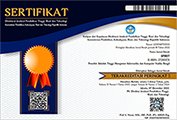PERTAHANAN PENCEGAHAN SERANGAN SOCIAL ENGINEERING MENGGUNAKAN TWO FACTOR AUTHENTICATION (2FA) BERBASIS SMS (SHORT MESSAGE SYSTEM)
Abstract
Keywords
Full Text:
PDFReferences
Chetioui, K., Bah, B., Alami, A. O., & Bahnasse, A. (2022). Overview of Social Engineering Attacks on Social Networks. Procedia Computer Science, 198, 656-661.
Mashtalyar, N., Ntaganzwa, U. N., Santos, T., Hakak, S., & Ray, S. (2021, July). Social engineering attacks: Recent advances and challenges. In International Conference on Human-Computer Interaction (pp. 417-431). Springer, Cham.
Syafitri, W., Shukur, Z., Mokhtar, U. A., Sulaiman, R., & Ibrahim, M. A. (2022). Social Engineering Attacks Prevention: A Systematic Literature Review. IEEE Access.
Matyokurehwa, K., Rudhumbu, N., Gombiro, C., & Chipfumbuâ€Kangara, C. (2022). Enhanced social engineering framework mitigating against social engineering attacks in higher education. Security and Privacy, 5(5), e237.
Indarta, Y., Ranuhardja, F., Ashari, I. F., Sihotang, J. I., Simarmata, J., Harmayani, H., ... & Idris, M. (2022). Keamanan Siber: Tantangan di Era Revolusi Industri 4.0. Yayasan Kita Menulis.
Tirfe, D., & Anand, V. K. (2022). A survey on trends of two-factor authentication. In Contemporary Issues in Communication, Cloud and Big Data Analytics (pp. 285-296). Springer, Singapore.
Wang, Z., Zhu, H., & Sun, L. (2021). Social engineering in cybersecurity: Effect mechanisms, human vulnerabilities and attack methods. IEEE Access, 9, 11895-11910.
Tulkarm, P. (2021). A Survey of Social Engineering Attacks: Detection and Prevention Tools. Journal of Theoretical and Applied Information Technology, 99(18).
Hijji, M., & Alam, G. (2021). A multivocal literature review on growing social engineering based cyber-attacks/threats during the COVID-19 pandemic: challenges and prospective solutions. Ieee Access, 9, 7152-7169.
Yasin, A., Fatima, R., Liu, L., Wang, J., Ali, R., & Wei, Z. (2021). Understanding and deciphering of social engineering attack scenarios. Security and Privacy, 4(4), e161.
Subbalakshmi, C., Pareek, P. K., & Sayal, R. (2022). A Study on Social Engineering Attacks in Cybersecurity. In Innovations in Computer Science and Engineering (pp. 59-71). Springer, Singapore.
Barik, K., Konar, K., Banerjee, A., Das, S., & Abirami, A. (2022). An Exploration of Attack Patterns and Protection Approaches Using Penetration Testing. In Intelligent Data Communication Technologies and Internet of Things (pp. 491-503). Springer, Singapore.
Duarte, N., Coelho, N., & Guarda, T. (2021, November). Social Engineering: The Art of Attacks. In International Conference on Advanced Research in Technologies, Information, Innovation and Sustainability (pp. 474-483). Springer, Cham.
Cialdini, R. B. (2009) Influence: the psychology of persuasion. HarperCollins e-books
Salahdine, F., & Kaabouch, N. (2019). Social engineering attacks: A survey. Future Internet, 11(4), 89.
Conteh, N. Y. (2021). The dynamics of social engineering and cybercrime in the digital age. In Ethical Hacking Techniques and Countermeasures for Cybercrime Prevention (pp. 144-149). IGI Global.
Siddiqi, M. A., Pak, W., & Siddiqi, M. A. (2022). A study on the psychology of social engineering-based cyberattacks and existing countermeasures. Applied Sciences, 12(12), 6042.
Mahmood Saqib, R., Shahid Khan, A., Javed, Y., Ahmad, S., Nisar, K., A Abbasi, I., ... & Ahmadi Julaihi, A. (2022). Analysis and intellectual structure of the multi-factor authentication in information security. Intelligent Automation & Soft Computing, 32(3), 1633-1647.
Matelski, S. (2022, June). Human-Computable OTP Generator as an Alternative of the Two-Factor Authentication. In Proceedings of the 2022 European Interdisciplinary Cybersecurity Conference (pp. 64-71).
Suhyana, F. A., Suseno, S., & Ramli, T. S. (2021). Transaksi Ilegal Menggunakan Kartu ATM Milik Orang Lain. SIGn Jurnal Hukum, 2(2), 138-156.
Bodhi, S., & Tan, D. (2022). Keamanan Data Pribadi dalam Sistem Pembayaran E-Wallet Terhadap Ancaman Penipuan dan Pengelabuan (Cybercrime). UNES Law Review, 4(3), 297-308.
Faircloth, C., Hartzell, G., Callahan, N., & Bhunia, S. (2022, June). A Study on Brute Force Attack on T-Mobile Leading to SIM-Hijacking and Identity-Theft. In 2022 IEEE World AI IoT Congress (AIIoT) (pp. 501-507). IEEE.
DOI: http://dx.doi.org/10.53567/spirit.v14i2.260
Refbacks
- There are currently no refbacks.
Copyright (c) 2022 Slamet Slamet

This work is licensed under a Creative Commons Attribution 4.0 International License.
Diindeks Oleh:
SPIRIT : Sarana Penunjang Informasi Terkini
Diterbitkan oleh Teknologi Informasi Institut Teknologi dan Bisnis Yadika Pasuruan
Alamat Redaksi: Jl. Bader No.9, Kwangsan, Kalirejo, Kec. Bangil, Pasuruan, Jawa Timur 67153
Telp/Fax: (0343) 742070 , Email : lppm@stmik-yadika.ac.id
Google Maps : Klik Disini

Karya ini dilisensikan di bawah Lisensi Internasional Creative Commons Atribusi 4.0 .







1.png)







